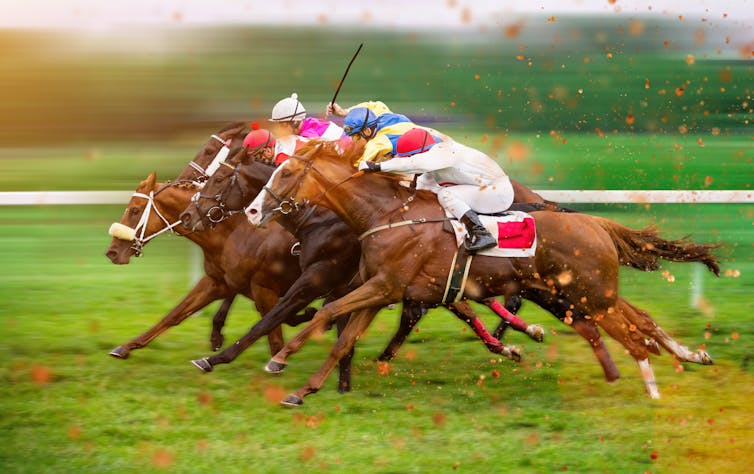
When the British Horseracing Authority (BHA) released its recent whip consultation report, it claimed to have consulted the science. But it insists whipping doesn’t hurt horses and fails to recommend that the racing industry changes its approach.
The BHA recognises two uses of the whip. For encouragement, to activate the horse or trigger a gear change in speed. And for safety of the horse and rider such as when jumping an obstacle. It recommends that whipping “for safety and encouragement” should continue. Industry leaders and jockeys say that whip use is essential to keep horses and jockeys safe.
The BHA report says using a whip as a form of “encouragement” acts “as an aid to activate the horse, which motivates a horse to give of its best and realise its potential in a race”. This gives the impression that striking horses with a partially padded rod is in their interest, like making your children eat their vegetables. But the scientific research into how horses experience whipping reveals a different story.
Horses evolved to run away from painful pressure on their hindquarters, given the most likely natural cause of such stimulation is contact from a predator. Whips evoke this evolutionary response to deter horses from slowing down in the closing stages of a race. But, in contrast to contact from a pursuing predator, whip strikes from a jockey are totally inescapable and so may give horses a sense of learned helplessness.
A 2020 study showed that horses’ skin is just as sensitive as humans’ by comparing skin samples under the microscope and exploring any differences in their skin structure and nerve supply. It found the outer layer of horses’ skin is no thicker (or more protective) than in humans. So if whip strikes cause pain to humans, they are likely to hurt horses.
When it comes to changing a horse’s behaviour, whips are used in racing as a form of punishment (for its failure to perform), not encouragement (to realise its potential).
What the report says
The report recommends one change to the way whips are used: to restrict their use for “encouragement” to the backhand position only. In racing, whips are held like a ski pole (backhand) or like a tennis racquet (forehand). The BHA’s rationale for moving to backhand-only strikes is that “the backhand discourages a wide arm action, which is not only neater and more stylish it also reduces the likelihood that the whip will be used with excessive force and/or from above shoulder height”. The report adds that “it is more difficult, though of course not impossible, to strike a horse with excessive force from the backhand position”.
Yet a 2013 study, not listed in the BHA report, showed that when jockeys whipped with their dominant hand, they struck with more force in the backhand than the forehand position. Stylish or not, promoting backhand strikes is bad for horses if forehand strikes are milder.
The report also recommended the BHA, on behalf of the racing industry, should commission and support objective research into the effects of the whip, using scientific advances to inform its policy. Conspicuously, it failed to specify what more science was needed.

When the BHA reviewed whipping in 2011, it also concluded that whipping stimulates a horse and doesn’t cause pain. This time around, the report confined itself to simply providing a list of papers published since 2011 about whipping, without discussing any of them.
The 2022 report reveals that this year some panel members felt there was enough evidence to remove the use of whips for “encouragement” now. So why the call for “more science”?
The 2022 report reveals that this year some panel members felt there was enough evidence to remove the use of whips for “encouragement” now. So why the call for “more science”?
What about safety?
The report says “in general, a focused, appropriately activated horse will tend to race more safely”, but it does not elaborate further on how whipping keeps a horse and jockey safe.
This view runs counter to a 2020 study (listed, but not discussed, in the report) which compared whipping-free races for apprentices (in which whips are held but not used) with races in which the actual use of the whip is allowed.
Races of both types were meticulously matched for racecourse, distance, number of horses starting each race, and “the going” (turf conditions on the day). A detailed analysis of stewards’ post-race reports revealed no difference between the two race types in movement of horses across the track and interference with other horses. There was no evidence that whipping improved safety.
Do whips improve performance?
The received wisdom is that whipping a horse makes it more likely to win. However, a landmark study published in 2011 showed increased whipping does not significantly affect a horse’s speed at the finishing line. This reflects the reality that, as they finish a race, most horses are losing speed because they are fatigued. The comparison study mentioned above also found no difference in finishing times between whipping-free and conventional races.
While the ethics of promoting gambling is a different debate entirely, whip-free races in Norway and the UK still allow people to bet. It may even be more attractive to sponsors seeking assurance their brand is associated only with ethical activities.
What others think
A spokesperson for the BHA told The Conversation: “The BHA’s whip review was the most detailed and rigorous of its type carried out by a racing body. It included a detailed public consultation, and recommendations were made by a steering group which contained expertise from across the racing and equine industry, alongside neutral and external participants including from the equine welfare sector and government.
"It included detailed consideration of public sentiment and the scientific landscape. It should be noted that the whip can only be used in racing for safety, correction, or to activate or encourage a horse, never to coerce. As a result of the whip review British racing will now have amongst the most strict and innovative whip rules in world racing.”
All horse riding, including so-called natural horsemanship, involves some form of negative reinforcement. This involves applying pressure until the horse responds the way you want it to. A position statement from the International Society for Equitation Science says trainers should use minimal force and avoid punishing horses or making them feel scared. They oppose jockeys whipping horses to improve their position in a race.
Animal ethicists say people should apply the precautionary principle and “err on the side of caution” when animals are made to participate in human activities. But the BHA rejected the precautionary principle because of the “proportionality of the principle in relation to this issue”.
In contrast, the website of the charity World Horse Welfare states: “We need to assume that if a procedure causes pain in humans and leads to a response in horses, then it causes that response by causing pain.” It concludes that whipping for encouragement should be banned. Photographic evidence that the padded whip can leave welts on horses underscores this point.
An Animal Aid-funded 2018 YouGov study found that 68% of adult respondents in the UK either oppose (30%) or strongly oppose (38%) the use of the whip in racing. When excluding those who did not express an opinion on the issue, the number of respondents who oppose or strongly oppose the use of the whip in racing rose to 83%.
The turning tide
Groups that the BHA once considered allies are now openly criticising its stance on whipping. In part as a result of the 2022 consultation, the RSPCA (England and Wales) and World Horse Welfare have withdrawn support on whipping horses for encouragement.
It is easy to see why whipping in horseracing has become a touchstone issue, disliked by the majority of the public and a central threat to racing and other equestrian sports’ social license to operate. When the justification for whipping tired horses comes down to semantics, how much longer will society tolerate this violent form of “encouragement”?
Professor Paul McGreevy is an Honorary Fellow of the International Society for Equitation Science and a life member of the RSPCA NSW. He has received funding from the Australian Research Council for research into the welfare of racing Thoroughbreds. He occasionally conducts research funded by the RSPCA Australia.
Bidda Jones is employed by the Australian Alliance for Animals. She is a member of the Thoroughbred Aftercare Welfare Working Group which provides independent advice to the Australian Thoroughbred breeding industry.
This article was originally published on The Conversation. Read the original article.







